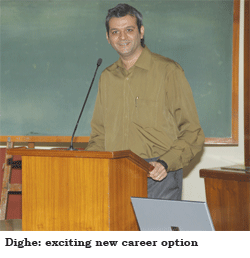With breakthroughs of monumental importance being made in the world of physical sciences, suddenly a career in physics has become an exciting option for science scholars
“In recent years, we have had exciting developments like the discovery of the Higgs boson, dark matter and dark energy in the world of physical sciences (aka physics). Numerous applications of nanomaterials and high temperature superconductors are being developed as we speak. We can now create cooler temperatures in labs than anywhere in the universe and better vacuums than exist between galaxies. This is the excitement that study of physics enables an individual to experience,’’ says Dr. Amol Dighe, professor of physics at the globally respected Tata Institute of Fundamental Research (TIFR), Mumbai, winner of the prestigious Swarna Jayanti Fellowship of the Department of Science and Technology, Govern-ment of India, in 2010 and a fellow of the Indian Academy of Sciences, Bangalore.
With breakthroughs of monu-mental importance being made in quantum theory and in the fields of atomic and nuclear physics, demand for qualified physicists is rising exponentially. Suddenly a career in physics has become an exciting and even remunerative option for bright science scholars.
Physics is a fundamental science. Chemists, engineers, biol-ogists as well as doctors require knowledge of basic physics. Qualified physicists tend to prefer working in astrophysics, geophysics, medical physics, nuclear physics, meteorology, astronomy and biophysics. After postgraduation, career options include teaching, research, or employ-ment in corporate and medical physics organisations.
Master of physics programmes are offered by almost all universities countrywide. The Indian Institutes of Technology (IITs) offer a five-year integrated M.Sc programme in physics for which admission is via the IIT-JEE (joint entrance examination). However, for specialised Masters and doctoral research programmes, the most reputable institutes are TIFR, Mumbai, which also has campuses in Pune, Bangalore and Hyderabad; Indian Institute of Science, Bangalore; Harish Chandra Research Institute, Allahabad; Inter-University Centre for Astronomy and Astrophysics, Pune; Saha Institute of Nuclear Physics, Kolkata; Physical Research Laboratory (PRL), Ahmedabad; and the Indian Institute of Science, Education & Rese-arch, (IISER, Pune, Kolkata, Mohali). Admission into these programmes is through written tests and interviews. Ph D programmes are open to physics postgraduates and post-doctoral progr-ammes are available to qualified Ph Ds in physics.
 If the laws of physics open up the world of physical sciences, their application creates a variety of job opportunities. The list ranges from analysts and teachers to researchers and scientists in areas as diverse as space sciences and nuclear energy to industrial research. “To get a faculty position, there is a rather long incubation period. After completing a Masters degree, one needs to do five-six years research on a dissertation to get a Ph D. After that, post-doctoral research for two-five years is mandatory before qualifying for a faculty position. Because of this long gestation period, postgrads studying for a Ph D are paid a stipend of Rs.15,000-20,000 per month, and Rs.20,000-35,000 while doing post-doctoral research. Subsequently, a faculty member can expect a pay package of Rs.50,000-70,000 per month under Sixth Pay Commission norms. Several institutes which value research also provide perks such as HRA/ housing, start-up research grants and young faculty fellowships. Moreover, in the corporate sector, pay packages can run into several lakhs per month,” says Dighe.
If the laws of physics open up the world of physical sciences, their application creates a variety of job opportunities. The list ranges from analysts and teachers to researchers and scientists in areas as diverse as space sciences and nuclear energy to industrial research. “To get a faculty position, there is a rather long incubation period. After completing a Masters degree, one needs to do five-six years research on a dissertation to get a Ph D. After that, post-doctoral research for two-five years is mandatory before qualifying for a faculty position. Because of this long gestation period, postgrads studying for a Ph D are paid a stipend of Rs.15,000-20,000 per month, and Rs.20,000-35,000 while doing post-doctoral research. Subsequently, a faculty member can expect a pay package of Rs.50,000-70,000 per month under Sixth Pay Commission norms. Several institutes which value research also provide perks such as HRA/ housing, start-up research grants and young faculty fellowships. Moreover, in the corporate sector, pay packages can run into several lakhs per month,” says Dighe.
Born and schooled in Mumbai, Dighe was a top-ranker in IIT-JEE and was admitted into the B.Tech engineering programme of IIT-Bombay in 1992. After a Masters degree in 1994, Dighe wrote his Ph D dissertation on particle physics “which is about the fundamental laws of nature derived from experiments with particle colliders,’’ at the University of Chicago, which awarded him a Ph D in 1997. After conducting post-doctoral research in the International Centre for Theoretical Physics, Trieste, Italy, CERN (Geneva) and the Max Planck Institute for Physics, Munich for six years, Dighe returned to India and signed up with TIFR as a faculty member and professor of physics involved in research and teaching.
According to Dighe, the quality of physics education and research has improved greatly in the past decade. “A number of universities, deemed universities, IITs and new institutes like the IISERs, NISER (National Institute for Science Education and Research), and CBS (Centre for Excellence in Basic Sciences), have mushroomed across the country which augurs well for physics students and research,” he says.
Even within TIFR, the tempo of research activity is accelerating. “We are currently involved in a mega experiment of excavating under a mountain near Madurai, where we expect to discover particles called neutrinos with which we intend to build the largest electromagnet in the world. For students with scientific aptitude and aspirations, the brave new world of physical sciences offers exciting voyages of discovery,” says Dighe.
Way to go, Prof!
Indra Gidwani (Mumbai)